A well-designed home office makes a big difference in your work and life. When you have the right setup, your Home Office Ideas can help with comfort, reduce strain, and improve how you focus and work productively. Remote work is not just temporary but a growing lifestyle. A space that supports you physically and mentally pushes your creativity, gives you energy, and helps you stay on task. This post gives you practical, stylish, and affordable home office ideas so you can build a space that enhances your concentration, posture, and mood. You will learn how to choose a space, pick furniture, use lighting, add personality, and manage costs smartly with focus keywords in mind.
1. Choosing the Right Space
Pick a quiet corner of your home or a room with natural light so you can avoid distractions and feel calm. A place where sunlight comes in but where your screen does not reflect glare helps your eyes and energy. If you live in an apartment, turning a closet or small nook into your workspace can work well. Use multi‐purpose rooms carefully: if your home office shares space with a guest room or living room, use screens or dividers to separate zones visually and mentally.
Small spaces demand clever solutions. Choose furniture that fits well and use vertical shelving. Make sure entrances are not blocked and pathways are clear. Think about noise levels from outside or other rooms. If possible, find a spot that does not directly face noisy areas. Use rugs or soft materials to absorb sound. With the right choice of space, your Home Office Ideas will store stress away and let concentration grow naturally.
2. Layout and Ergonomics
Position your desk so windows are to the side if possible. This way you get natural light without glare on screens. Make sure your screen height is at your eyes or slightly below. Adjust your chair so your knees are level or slightly lower than your hips. Use ergonomic chairs that support your lower back to avoid fatigue. Sitting long hours can hurt posture, so adjust height or use footrest or cushion support.
Standing desks can help, especially if you alternate between sitting and standing. They reduce the risks of sitting too long and improve blood flow, but they may introduce fatigue in the legs if overused. Choose one only if you can change posture often. Manage cables with clips, trays, or under‐desk mounts to avoid clutter. Clean cable layout reduces stress and keeps power and data cords from tripping or tangling. A clean, ergonomic layout supports physical health and mental clarity among your Home Office Ideas.
3. Furniture That Works as Hard as You Do
Choose desks that suit your room size and work style. If space is tight, pick compact desks with narrow depth or corner desks that use wall space well. For storage, floating shelves or wall organizers help keep things off the floor and maintain visual calm. Drawer units that slide under desk keep essentials close without clutter. Convertible furniture like fold‐away desks or tables that double as dining or console tables give flexibility when space is limited.
Look at real examples. IKEA makes desks with adjustable heights and modular design that allow you to grow the workspace as your needs change. Wayfair has storage smart pieces that combine style and function. Local furniture stores often offer custom sized pieces that match your room dimensions. Use furniture that keeps your workspace clean, supports your posture and delivers style without sacrificing utility. These Home Office Ideas make your furniture do more for you, not the other way around.
4. Lighting: The Silent Productivity Booster
Natural light is restful for eyes and gives a boost to your mood. If you place your desk near windows, you gain this benefit. Watch out for direct sunlight that hits screens; adjust with blinds or curtains. When natural light is weak, use artificial lighting layers. Ambient lighting lights the room softly, task lighting helps work areas like desk or reading corners, accent lighting adds style or highlights objects like artwork.
You do not need expensive fixtures for good light. Clip lamps, LED strips, or affordable daylight bulbs imitate natural light and save energy. For video calls, ensure front lighting that avoids shadows on your face. Try soft diffused light from a lamp behind the camera or ring light if needed. The right lighting boosts your energy, reduces eye strain, and helps you appear polished during meetings. These lighting elements are central in many effective Home Office Ideas.
5. Aesthetic and Style Inspiration
Clean lines, neutral tones, and clutter‐free surfaces create a minimalist design that helps your mind relax. Scandinavian style builds on light woods, simple shapes, and cozy textures. It makes the room feel light, calm, and inviting. Industrial design adds bold contrast with metal accents, darker woods, and hints of gritty materials that provide character. Boho styles bring warmth with plants, color accents, patterned textiles, and decorative textures that stimulate creativity.
A transformation story helps. Imagine a messy corner with piles and no real desk. After, there is a slim desk, two floating shelves, a small plant, a lamp, and a clean wall. The space feels open and inspiring. Style matters because it affects mood; good aesthetics make you want to stay, work, and keep things tidy. Many Home Office Ideas succeed because they look beautiful and feel personal.
6. Personalization and Motivation
Adding your artwork, photos, or souvenirs reminds you of what you love and why you work. Personalized touches spark joy and keep motivation high during long days. Colors affect how you feel: blues calm you, greens balance, yellows energize. Choose wall paint, desk accessories or even a rug that supports the mood you want. Use low‐maintenance plants like snake plant, pothos, or ZZ plant to improve air quality and add life. They need little water yet bring fresh, natural vibes.
Sound and scent also shape your focus. A diffuser with lavender or citrus scent can calm or uplift you. Background music or nature sounds help mask noise but avoid lyrics that distract. White noise apps or soft instrumental playlists work well. With smart personalization, your space becomes not just a place to work but a place that nurtures focus, creativity, and well‐being under these Home Office Ideas.
7. Tech Essentials and Smart Upgrades
Your tech basics include a good monitor sized to your work, a comfortable keyboard and mouse, and reliable high‐speed Wi-Fi. If internet lags, switch to wired connection or upgrade router. Smart additions can include adjustable lighting controlled by voice, wireless chargers so cords dont clutter, and voice assistants that help with reminders or music. Upgrades need not cost much but should solve real problems.
Noise control matters. Use soundproof panels if needed or add rugs, curtains which absorb sound. Noise‐cancelling headphones help when focus is easy to lose. Manage power safely: use power strips with surge protection, hide cords, avoid overloading sockets. With sturdy tech setup, your productivity rises, interruptions fall, and your Home Office Ideas become investments in your work’s quality.
8. Budget-Friendly Home Office Ideas
DIY upgrades often save money. Use an old door as tabletop, repurpose crates for shelving, or repaint furniture instead of buying new. Affordable touches like peel-and-stick wallpaper, fresh paint, or thrifted items add character without high cost. Storage hacks include roll-away carts under desk, wall pockets, or hooks behind doors. These squeeze value out of every inch.
Where you shop matters. Local second-hand stores, online marketplaces, discount furniture retailers offer good deals. Seek quality materials when possible. Even less expensive pieces can last if made of solid wood or steel. Budget does not mean cheap look; smart choices let you achieve stylish, comfortable workspaces without spending too much. Budget in these Home Office Ideas is about value, not price.
9. Creating Boundaries Between Work and Home Life
A routine helps. Get up, dress, start at a certain time. At the end of day, switch off tools and tidy workspace to signal work is over. Visual separation helps too: rugs, screens, or curtains make work zone feel separate from rest or play zones. Use these to trigger your mind to switch into work mode or rest mode.
Also build in break zones inside or near workspace. A chair for coffee, a corner to stretch, or a spot for meditation helps you reset during work. Families need special plans: quiet hours, shared spaces rules, using headphones or communication to avoid interruptions. Boundaries guard your peace, keep your mental health safe, and support Home Office Ideas that sustain you long term.
10. Real-Life Examples and Design Inspiration
Case study one describes a small bedroom under stairs converted into a workspace with a fold-away desk, shelves, and soft lighting. After the makeover, the person reported less stress and more consistent hours. Case study two shows a large room used for both guest room and office; reuse of furniture, clever dividers, and minimal decor made both functions work without clash. Case study three features a compact urban flat using vertical storage, light colors, and mirrors to feel larger.
Before-and-after comparisons reveal changes like removing heavy curtains, clearing piled objects, replacing bulky furniture, repositioning lighting. These changes make rooms feel brighter, airier, calmer. Inspiration from real people shows that Home Office Ideas need not be grand or perfect. They must match your space, your budget, and your style to truly improve your daily work.
11. Final Touches: Making It Yours
Begin with small upgrades: replace bad lighting, adjust screen height, clear clutter. Perfecting every detail later is okay. Comfort should come first, appearance can follow over time. Make sure each change respects your health, daily routine, and preferences. The best home office reflects you: your habits, your body, your needs.
Summing up, pick a good space, use ergonomic furniture, get smart lighting, personalize with color and items you love, manage tech, and set boundaries. When each element works together, your workspace feels like support, not like a pressure. Your Home Office Ideas become much more than decor; they become your foundation for focused, comfortable, productive work.
Conclusion
Your Home Office Ideas are about creating a space that fits you, not copying others. The best home office is not the biggest or most expensive but the one that keeps you comfortable, focused, and productive. Start small, make one change at a time, and watch how your work becomes better. Use what you learned today and begin rethinking your space now to support your health, creativity, and efficiency.
Frequently Asked Questions
| Question | Answer |
| What is the ideal desk height for comfort? | Desk that lets your elbows rest at about 90 degrees and your forearms parallel to floor when typing. Seattle Standards suggest 28-30 inches for many people. |
| How can I avoid glare on my screen from windows? | Position your desk side-ways to windows, use blinds or curtains, use anti-glare screens, or reposition the monitor angle slightly. |
| Are standing desks better than sitting desks? | They help reduce risks of sitting all day. But alternating sitting and standing is best. Too long standing can strain legs or feet. |
| What lighting temperature is best for focus? | Bulbs around 4000-5000 Kelvin mimic daylight and help alertness. Warm white (2700-3000K) feels cozy but may reduce sharp focus. |
| How do I balance personal style with professionalism in video calls? | Choose a neutral, tidy background, add a tasteful plant or artwork, and make sure lighting is soft and even. Avoid busy or distracting objects. |
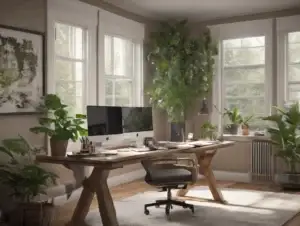
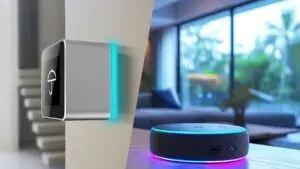
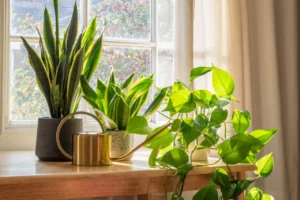
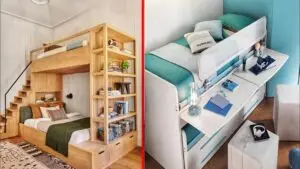
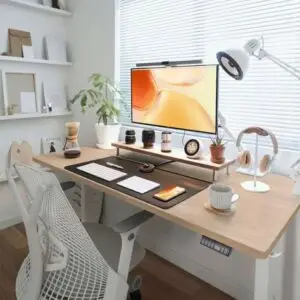

2 thoughts on “Home Office Ideas That Boost Comfort, Focus and Productivity”